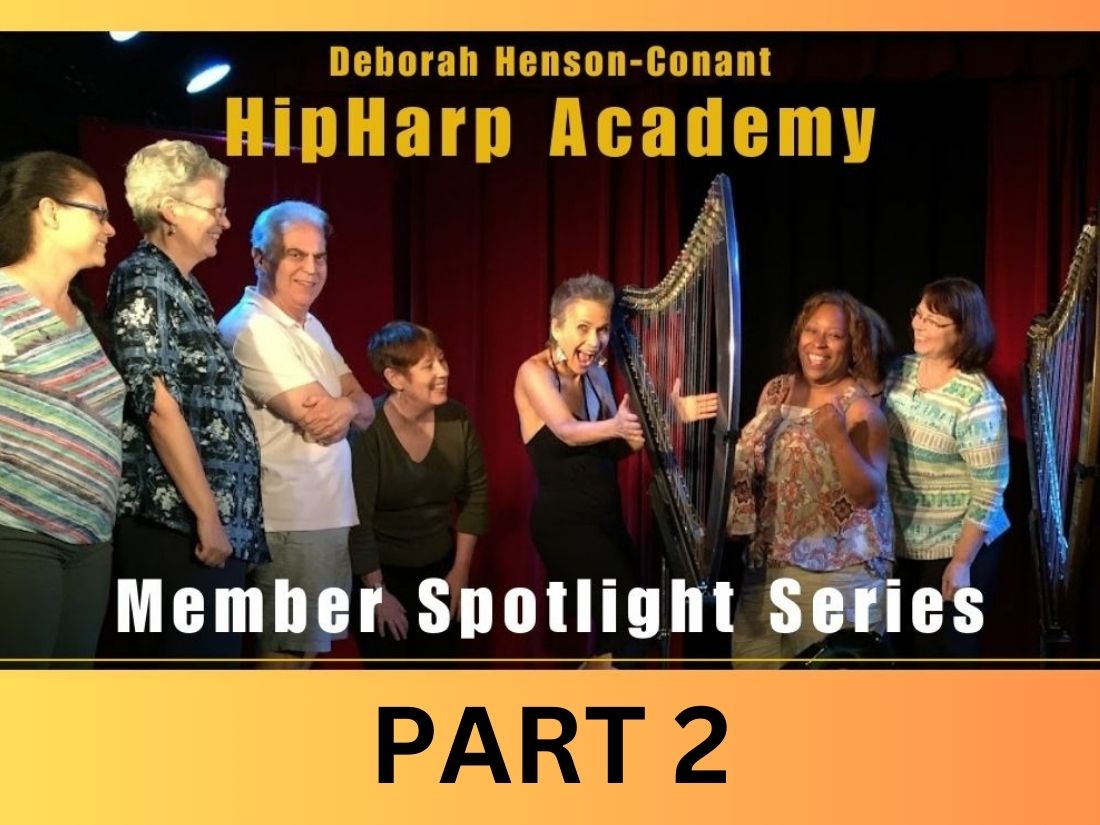
Welcome to Part 2 of Hip Harp Academy Member Spotlight Series
For the last 3 months, the members of Hip Harp Academy have been stretching themselves creatively, learning to put their creative expression into forms that they can share with others. Now they’re sharing that with you – in the form of these video shares.
How to enjoy these wonderful video shares: Enjoy the creativity and the willingness to share. Think about the fact that each of these videos is a unique creation – none of these musicians are playing written sheet music – they’ve created these arrangements by learning the fundamentals of arrangement and improvisation and putting them into play – literally – in their own creations.
Read their own account of their personal creative journey in creating each video by clicking the toggle beneath each video – and I encourage you to do that if you really want to be inspired.
Some of the players have played for years, and even decades – some have come to the harp as adults – some even as a retirement gift for themselves. We’re a community connected by a commitment to creative expression. Every week we meet for masterclasses and training, during the week we practice the new ideas and the willingness to be vulnerable, authentic and self-expressed with our instruments, our voices and ourSELVES.
So be inspired by that commitment, let it infuse your own life – and if you play the harp, come join us at Hip Harp Academy.
See all the Academy Member Spotlight Series:
Part #1 – Part #2 – Part #3
Melinda Ostrander-Aviles:
I wanted to challenge myself to create something new with the tissue technique, which turned out to sound like pizzicato strings. I also wanted to create an alto flute melody to pair with it.
Melinda's Insights about this Project
Describe your final project so I know exactly what you’re sending me.
This is my final beginning project for September 2023.
What principles from this course or from chats did you use to develop, perform, and record this project – and how did they play a part in your process?
Last week DHC showed us a technique using a tissue to muffle the strings. I was inspired to try it.
Give a short description of what it took for you to be able to play what you did – both logistically and emotionally.
I wanted to challenge myself to create something new with the tissue technique, which turned out to sound like pizzicato strings. I also wanted to create an alto flute melody to pair with it. This is just an experiment which I created last night.
What freedoms and blocks within yourself did you connect with (or struggle with) in the process?
I struggled with getting things to work exactly as I wanted to; ended up improvising and accepting limitations in order to create something quickly.
What challenges did you meet while connecting with your own freedom of expression in this project?
I also wanted to try to create the pizzicato with the flute and a resonant melody with the harp to go with it.
What other parts of your life were impacted by what you learned in this class, and how?
I always enjoy the snippets, as well as hearing what other people are creating.
What were your personal “Ahas”?
My aha here was that there is always more to learn and experiment with, and that I CAN create something with new techniques, even with limited harp skills.
Is there anything else you want people to know when they watch your video?
I recorded the audio in Soundtrap, exported the file and then imported it into StoryBlocks. Then I added stock video. I felt like the pizzicato sound evoked the feeling of raindrops.
Joke Verdoold:
My desire to play this piece and the realisation it was way beyond me, lead me to to make it simpler and study it in little snippets. After I finally got the snippets in my fingers and in my memory, I could start to glue them together and rebuild the piece in my own way.
Joke's Insights about this Project
Describe your final project so I know exactly what you’re sending me.
This is my version of “Nataliana.”
What principles from this course or from chats did you use to develop, perform, and record this project – and how did they play a part in your process?
After having it broken down to an almost bare framework, i could slowly start to build it up again.
Give a short description of what it took for you to be able to play what you did – both logistically and emotionally.
My desire to play this piece and the realisation it was way beyond me, lead me to to make it simpler and study it in little snippets. After I finally got the snippets in my fingers and in my memory, I could start to glue them together and rebuild the piece in my own way. And ultimately I could start to put some more notes/chords to it.
What freedoms and blocks within yourself did you connect with (or struggle with) in the process?
No freedoms and no blocks, just annoyance, waywardness and perseverance
What challenges did you meet while connecting with your own freedom of expression in this project?
I strived to play fluid, and use soft and loud.
What other parts of your life were impacted by what you learned in this class, and how?
I had less time for my other highly necessary and deadlined chores. So I got in the survival mode.
What were your personal “Ahas”?
“If you can’t do it as it should, then do it as you can.”
Is there anything else you want people to know when they watch your video?
Please, enjoy the video and meanwhile be happy you were not with me when I was working on this piece.
Lynne Lapidus:
I’m finding I’m getting emotional about my songs lately, but once I finish them enough to record them, it is kind of cathartic and the emotions aren’t as raw ( for a while, anyway). On the other hand, if a song makes me cry, I think it must be a good song.
Lynne's Insights about this Project
Describe your final project so I know exactly what you’re sending me.
I finished the song I was working on. This isn’t my best rendition, and I couldn’t get it into Canva to try out editing, which I wanted to do, so I’m attaching the picture I was going to simply end it with. It has been retitled: Unconditional Love (Ode to Harmony), but I messed up when I uploaded it to YouTube – just shows the date.
What principles from this course or from chats did you use to develop, perform, and record this project – and how did they play a part in your process?
It started with a snippet. And it morphed from one song to another. I took the patterns from my first song, then reimagined them by reversing things and it became a whole new song.
Give a short description of what it took for you to be able to play what you did – both logistically and emotionally.
I’m finding I’m getting emotional about my songs lately, but once I finish them enough to record them, it is kind of cathartic and the emotions aren’t as raw ( for a while, anyway). On the other hand, if a song makes me cry, I think it must be a good song.
What freedoms and blocks within yourself did you connect with (or struggle with) in the process?
Well, see the above – have to release the emotions at least enough to be able to get through the song, yes?
What challenges did you meet while connecting with your own freedom of expression in this project?
The feeling that I was writing two indistinguishable songs.
What other parts of your life were impacted by what you learned in this class, and how?
I love that these are music PRINCIPALS. And I’ve gone back a bit to my first instrument – the piano – and with the limit of that dexterity, I find I can apply the principals and play things on the piano that I’d never played before. Nothing spectacular, but fun and interesting, nonetheless.
What were your personal “Ahas”?
Life is full of patterns and their variations. Some are the dull necessities of life, and some are interesting. Let’s spend time with the interesting ones!
Is there anything else you want people to know when they watch your video?
I wasn’t totally happy with my voice – especially the first held note, and the ending came out different every time I recorded, so I just went with this one because there was no light reflecting from the mirror on the left side. As good a reason as any! So it isn’t perfect!…
Romana:
If you follow the patterns, it can sound good even when you simplify the score or stray from the original.
Romana's Insights about this Project
Describe your final project so I know exactly what you’re sending me.
This is my attempt at Deborah’s Nightingale.
What principles from this course or from chats did you use to develop, perform, and record this project – and how did they play a part in your process?
It took me 5 years to learn this song, and I can’t play it well yet, but I can see the patterns now, which is very helpful.
Give a short description of what it took for you to be able to play what you did – both logistically and emotionally.
It took a great deal of practice and it still has many flaws, I had to accept I always make mistakes in it. I still love the song though, after all these years of practising and listening to it.
What freedoms and blocks within yourself did you connect with (or struggle with) in the process?
I struggled with the acceptance of all the errors I make and I enjoyed the expressiveness of the song.
What challenges did you meet while connecting with your own freedom of expression in this project?
My technical/speed limitations.
What other parts of your life were impacted by what you learned in this class, and how?
I try to look for the patterns when I study a new song.
What were your personal “Ahas”?
If you follow the patterns, it can sound good even when you simplify the score or stray from the original.
Marianne Sandoz:
This quarter I’ve discovered a form of improvisation that makes me feel good. I choose a sequence of notes for each hand, which I play over two different rhythms to create a shift.
Marianne's Insights about this Project
Describe your final project so I know exactly what you’re sending me.
It is about a non-human creature who listened to Nataliana long ago. Fragments have remained in their mind: the notes of the first chord are repeated obsessively in a mechanical rhythm, the melody in equal notes has become disembodied.
Nataliana carries the essence of friendship, and the Alien knows this intuitively, but they can’t get it because they don’t know anything about human feelings, and that drives them mad…
By some kind of mystical enlightenment, they can finally hear Nataliana’s original theme, but in the end, something goes wrong, and on an acidic chord, everything vanishes into the dark.
What principles from this course or from chats did you use to develop, perform, and record this project – and how did they play a part in your process?
I used basic snippets from Nataliana to create something personal (the Alien’s inner voice) and inserted Nataliana’s theme (the Alien’s external voice) to build a kind of collective thing (Nat-Aliena). Building collective things is, I think, one of Hip Harp Academy’s priceless and avant-garde characteristics.
Give a short description of what it took for you to be able to play what you did – both logistically and emotionally.
After listening to Nataliana for the first time and thinking it really had the sound of friendship, I heard words in my head, the ones I added to the video. They sounded like someone else’s voice. I knew they were ‘true words’ and I wanted to do something with them, but I didn’t know what. Then I let it go and the project built itself up.
What freedoms and blocks within yourself did you connect with (or struggle with) in the process?
This quarter I’ve discovered a form of improvisation that makes me feel good. I choose a sequence of notes for each hand, which I play over two different rhythms to create a shift. When it becomes mechanical, my mind sort of opens up, like when I fall asleep after insomnia. I think it has something to do with hand independence.
What challenges did you meet while connecting with your own freedom of expression in this project?
I still don’t understand the question.
What other parts of your life were impacted by what you learned in this class, and how?
Seeing this project through to the end makes me feel whole.
What were your personal “Ahas”?
Hearing that voice was great, and I’m determined to listen to it more often.
Is there anything else you want people to know when they watch your video?
For a few days now, I’ve had an old pedal harp at home. It has a single pedal movement for alterations, and when all the pedals are raised, it is tuned in Eb. In this respect, it is very similar to lever harps. It weighs ‘only’ 19 kg. It’s a folk instrument from the Tyrol (near Salzburg).
Yesterday I removed the plate behind the neck so I could tighten a few bolts to eliminate vibrations and annoying noises, to be able to record my project on this harp. Then I thought it would be fun to demonstrate the mechanism, so I recorded a video as an introduction. Hope you enjoy it.
Betty Herloski:
No fancy props or video enhancements- just me and my harp. Playing for myself this time, not being concerned with anything else.
Betty's Insights about this Project
Describe your final project so I know exactly what you’re sending me.
Nataliana – bare bones trying to add expression
What principles from this course or from chats did you use to develop, perform, and record this project – and how did they play a part in your process?
Slow down. Don’t be afraid to express yourself. These ideas helped me to really feel the music. Instead of practicing trying to get notes and written music perfect, I slowed down and let myself feel the music.
Give a short description of what it took for you to be able to play what you did – both logistically and emotionally.
I needed to let go of what I had previously had ingrained in myself for this music. I first played and recorded this in 2008. By listening to other harpists, classes, office meetings and catch up coaching I began to get the music and to understand how it made me feel.
What freedoms and blocks within yourself did you connect with (or struggle with) in the process?
I didn’t hide myself behind tech tricks and presentation of the video. I allowed myself to express how I was feeling. It’s hard to get over feeling I’m not good enough or I need to play something a certain way. It’s okay to do it my way.
What challenges did you meet while connecting with your own freedom of expression in this project?
Really opening myself up to the music and the feelings it invoked in me.
What other parts of your life were impacted by what you learned in this class, and how?
I’ve become a little more centered- slowing my brain don and allowing to let myself really feel what’s happening around me. How things impact me, how I respond to things. I’ve become more sensitive to to my feelings and allowing myself to feel them. Learning that I’m okay as I am. I can learn and grow – but also be me and not try to be someone else.
What were your personal “Ahas”?
Playing by following my own breathing, letting the music itself breathe and not trying to be perfect.
Is there anything else you want people to know when they watch your video?
No fancy props or video enhancements- just me and my harp. Playing for myself this time, not being concerned with anything else.
Christine Van Arsdale:
This is a modulation pattern that I worked on to smoothly move from C major to G major to D major and A major.
Christine's Insights about this Project
Describe your video so I know exactly what you’re sending me.
This is a modulation pattern that I worked on to smoothly move from C major to G major to D major and A major. The progression is I-vi-ii7-V7 and pivoting on the V7, which becomes I7 in the new key, where I proceed with the same chord progression.
TELL ME WHAT YOU NEED COACHING ON. Provide specific questions here so I know what you want me to give you feedback on. Remember, I’m not grading or assessing your work – I’m coaching – and I can only do that if I know what you’re TRYING to do, so I can gear my coaching to help you achieve that.
I would like to extend each progression, to make it a bit longer in each key.
Is there anything else you want me to know about your video?
Hopefully, I can remember to record it in landscape next
Harpists Who Dare!
Are you ready to free yourself from the notes on the page?
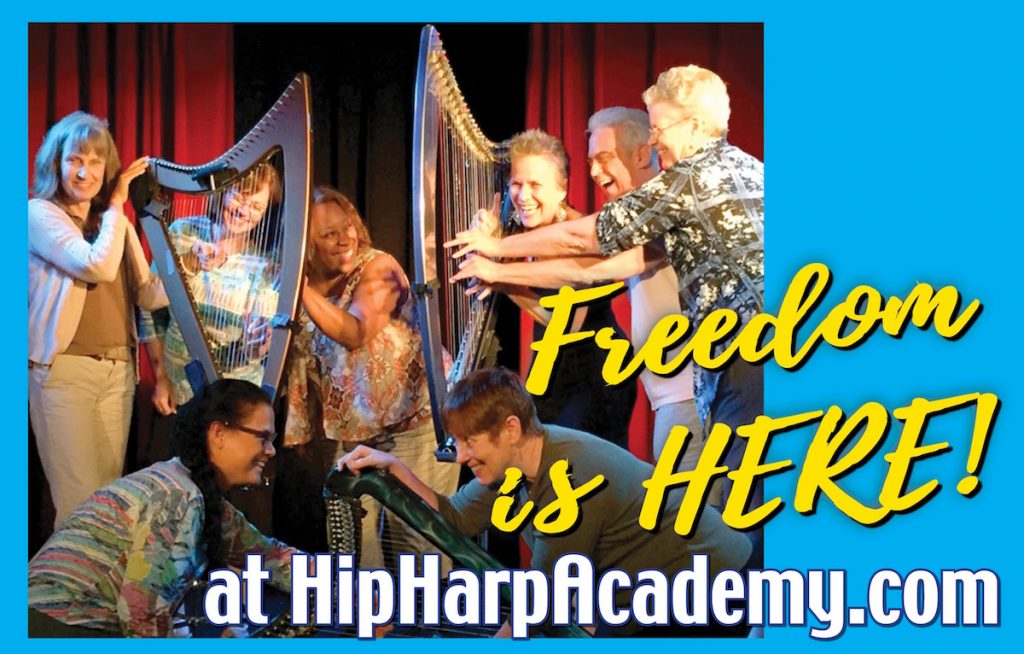
Join NOW and GET $400 OFF until Midnight Jul. 31


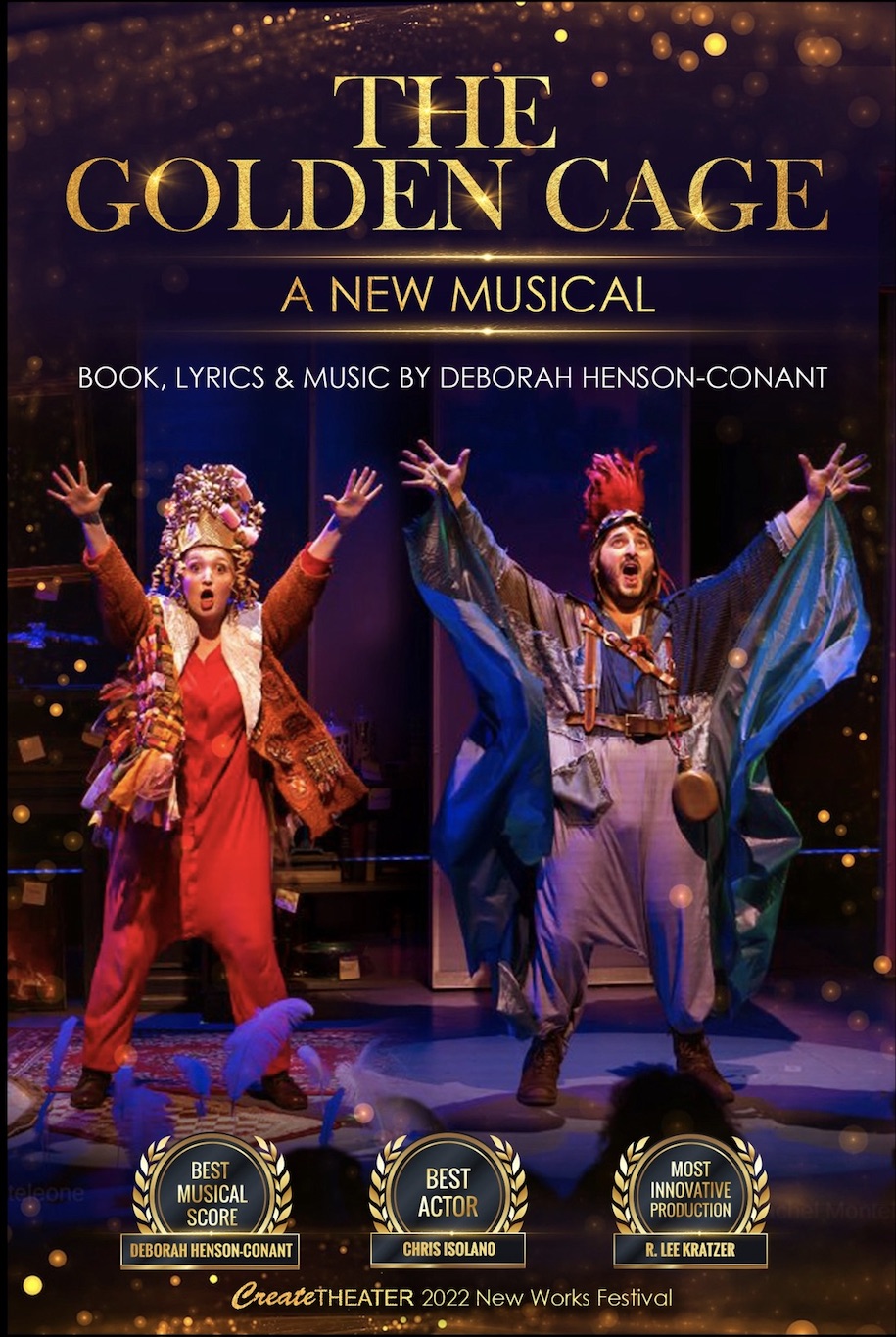
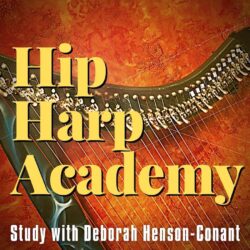
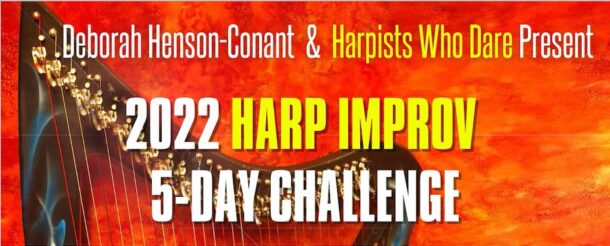
Join for Freebies, Stories & News
Join to get weekly-ish emails with stories, videos & events like concerts & classes
Yay! You should get my next newsletter within the next 7-10 days. I'm so happy we'll be in touch!
I won't ever share your email address with others - and you can unsubscribe anytime, tho most people say they really enjoy these weeklish emails.